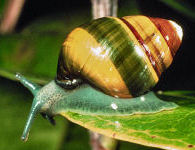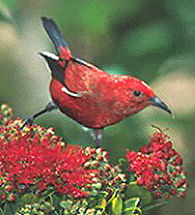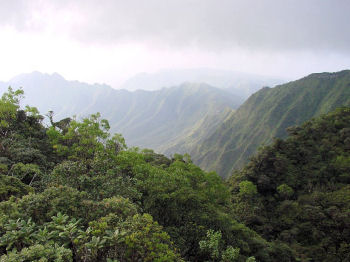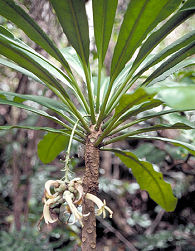
This page last revised 30 August 2006 -- S.M.Gon III
Introduction
Ecoregion
Conservation Targets
Viability
Goals
Portfolio
TNC Action Sites
Threats
Strategies
Acknowledgements
▫
Tables
Maps & Figures
CPT Database
Appendices
Glossary
Sources

The bulk of the species of the endangered genus Achatinella are found in the lowland wet system of the Ko'olau conservation area.

Although not a rich forest bird site, the wet forest of the Ko'olauconservation area supports common endemic birds such as this 'apapane (Himatione sanguinea).
Appendix:
O‘ahu Strategies
1998 ERP Strategic Summary
The 1998 ERP summarized strategies for thespecific needs of each ofthe conservation areas defined by the large native landscapes ofeach major island. The directives established then have largely beenrealized and continue to evolve. In 1998, TNC had one majorlandholding, a lease agreement with James Campbell Estate for thesummit crest region of the southern Wai‘anae Mountains. The ERPrecommended thefollowing for O‘ahu:
- We believe expanded conservation of Wai‘anae and Ko‘olausites depends on establishing an active partnership with the StateDivisionof Forestry and Wildlife, the U.S. Fish and Wildlife Service, the U.S. Army,theCity and County of Honolulu Board of Water Supply, and at least one ofthemajor private landowners (e.g., Kamehameha Schools Bishop Estate, theEstate ofJames Campbell, or Castle and Cooke, Inc.).
- The fledgling Ko‘olau watershed partnershipmay serve this purpose for the Ko‘olau range, but we would like to establish anisland-wide partnership with the above parties to identify and co-fund a set ofprojects to 1) test the feasibility of preventing alien species damage in themost intact, remote areas, 2) bring the best available stewardshipto a set of smaller, high-diversity “hotspots” at lower elevations, and 3)engage the O‘ahu community directly in the conservation of these places.
- TNC's proposed role is to re-deploy existingO‘ahu positions to promote such a partnership and help carry out itsprojects.
- We will also work to build thecapacity of the USFWS on the island via the establishment of the O‘ahu ForestNational Wildlife Refuge
- Sustain the U.S. Army's ecosystem managementprogram through cooperative projects and continued advocacy for funding of the program at the legislative level.
- Whether or not this partnershipadopts a vision of landscape-scale conservation for O‘ahu (versus concentratingonly on a set of smaller, intensively protected “specimen” sites for long-termmaintenance), TNC will pursue an aggressive community outreach strategy on thisisland to build political support for biodiversity conservation statewide.
- NOTE: see also the WaianaeMountains Site Conservation Plan.
2006 Strategic Update
TheArmy's efforts have been visible in both Ko‘olau and Wai‘anaelandscapes, and major mitigation planning for endangered species inMakua Valley (an Army Training Area in the Wai‘anae Mountains) proposesestablishment of numerous management units in both the Wai‘anae andKo‘olau Mountains. However, there has been no significant progress inan overall Wai‘anae Mountains Watershed partnership, though somesmaller, subregional partnerships are forming (e.g., in the Wai‘anaeKai - Makaha watersheds).
The USFWS O‘ahu Forest National Wildlife Refuge(4,775 acres) was established in December 2000, and has engaged in somecooperative management projects with the Army and DOFAW via the Ko‘olauMountains Watershed Partnership, including trail maintenance,remote campsite establishment, and limited weed control.
Use these links to access additional details about the two conservation areas of O‘ahu: Wai‘anae Conservation Area and Ko‘olau Conservation Area.

Native montane wet forest on the summit of Ka'ala, Wai'anae Mountains


